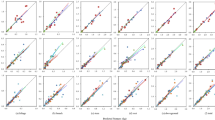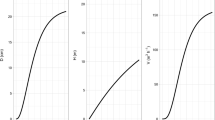Abstract
In the mid-western Himalaya (altitude 1350 m, rainfall 1100 mm), multipurpose trees found as escapees in agricultural fields or naturally growing in the forests, play an important role in providing fuel, fooder and small timber to the farmers. Shoot elogation, and tree architecture of 4 year old trees of Grewia optiva, Robinia pseudoacacia and Celtis australis (early successionals), and Quercus leucotrichophora, Q. glauca and Ilex odorata (late successionals), were analyzed. All the late successional species showed a proleptic type of bud and branch production, while the early successional trees made growth through syllepsis. The shoot elongation differed significantly (P <0.05) with the crown position, and ranged from 11 to 30 cm in different species. Early successional species tended to maintain a comparatively narrow crown and showed a significantly (P <0.05) higher ramification ratio, and multilayered canopy. The late successionals, in contrast, showed a wide crown with monolayered canopy, adapted to the weak light intensity. There was only one flush of leaves in Q. leucotrichophora and Q. glauca while in the rest of the species there were two distinct flush periods. The results are important for the management of agroforestry trees.
Similar content being viewed by others

References
Boojh R, Ramakrishnan PS (1982) Growth strategy of trees related to successional status. I. Architecture and extension growth. For Eco Manage 4: 359–374
Borchert R (1969) Unusual shoot growth in a tropical tree, Oreopanax (Araliaceae). Am J Bot 56: 1033–1041
Fisher JB (1986) Branching patterns and angles in trees. In: Givnish TJ (eds) On the economy of plant form and function, Cambridge University Press, New York, pp 493–523
Hallé F, Oldemann RAA, Tomlinson PB (1978) Tropical trees and forests: an architectural analysis. Springer, Berlin Heidelberg New York
Honda H, Fisher JB (1978) Tree branch angle-maximizing effective leaf area. Science 199: 888–890
Horn HS (1971) The adaptive geometry of trees. Princeton University Press, Princeton
Khosla PK, Toky OP, Bisht RP, Hamidullah S (1992) Leaf dynamics and protein content of six important fodder trees of the Western Himalaya. Agrofor Syst 18: 27–36
Kozlowski TT (1964) Shoot growth in woody plants. Bot Rev 30: 335–392
Kramer PJ (1943) Amount and duration of shoot growth in tree seedlings. Plant Physiol 19: 239–257
Kramer PJ, Kozlowski TT (1979) Physiology of woody plants. Academic Press, New York
Marks PL (1975) On the relation between extension growth and successional status of deciduous trees of the north-eastern United States. Bull Torrey Bot Club 102: 172–177
Nelson ND, Burk J, Icebrands JG (1981) Crown architecture of short rotation, intensively cultured Populus I. Effects of close spacing on first order branch characteristics. Can J For Res 11: 73–81
Pickett STA, Kempf JS (1980) Branching patterns in forest shrubs and understorey trees in relation to habitat. New Phytol 86: 219–228
Shukla RP, Ramakrishnan PS (1986) Architecture and growth strategies of tropical trees in relation to successional status. J Ecol 74: 33–46
Steingraeber DA, Kasht LJ, Frank DH (1979) Variation of shoot morphology and bifurcation ratio in sugar maple (Acer saccharum) sapling. Am J Bot 66: 441–445
Strahler AN (1957) Quantitative analysis of watershed geomorphology. Trans Am Geophy Union 38: 913–920
Toky OP, Kumar P, Khosla PK (1989a) Structure and function of traditional agroforestry systems in the Western Himalaya. I. Biomass and productivity. Agrofor Syst 9: 47–70
Toky OP, Kumar P, Khosla PK (1989b) Structure and function of traditional agroforestry systems in the Western Himalaya. II. Nutrient cycling. Agrofor Syst 9: 71–89
Whitney CG (1976) The bifurcation ratio as an indicator of adaptive strategy in woody plant species. Bull Torrey Bot Club 103: 67–72
Author information
Authors and Affiliations
Rights and permissions
About this article
Cite this article
Khosla, P.K., Toky, O.P., Bisht, R.P. et al. Growth patterns of early versus late successional multipurpose trees of the western Himalaya. Trees 10, 108–113 (1995). https://doi.org/10.1007/BF00192191
Received:
Accepted:
Issue Date:
DOI: https://doi.org/10.1007/BF00192191



